
Back مقارنة Arabic بەراوردکاری CKB Vergleich (Philosophie) German Método comparativo Spanish مقایسه (ذهن) Persian Méthode de comparaison French השוואה HE Komparo IO 비교 Korean Comparație (psihologie) Romanian



Comparison or comparing is the act of evaluating two or more things by determining the relevant, comparable characteristics of each thing, and then determining which characteristics of each are similar to the other, which are different, and to what degree. Where characteristics are different, the differences may then be evaluated to determine which thing is best suited for a particular purpose. The description of similarities and differences found between the two things is also called a comparison. Comparison can take many distinct forms, varying by field:
To compare is to bring two or more things together (physically or in contemplation) and to examine them systematically, identifying similarities and differences among them. Comparison has a different meaning within each framework of study. Any exploration of the similarities or differences of two or more units is a comparison. In the most limited sense, it consists of comparing two units isolated from each other.[1]
To compare things, they must have characteristics that are similar enough in relevant ways to merit comparison. If two things are too different to compare in a useful way, an attempt to compare them is colloquially referred to in English as "comparing apples and oranges." Comparison is widely used in society, in science and the arts.
- ^ Patrick Manning, Navigating World History: Historians Create a Global Past (2003), p. 279-80.